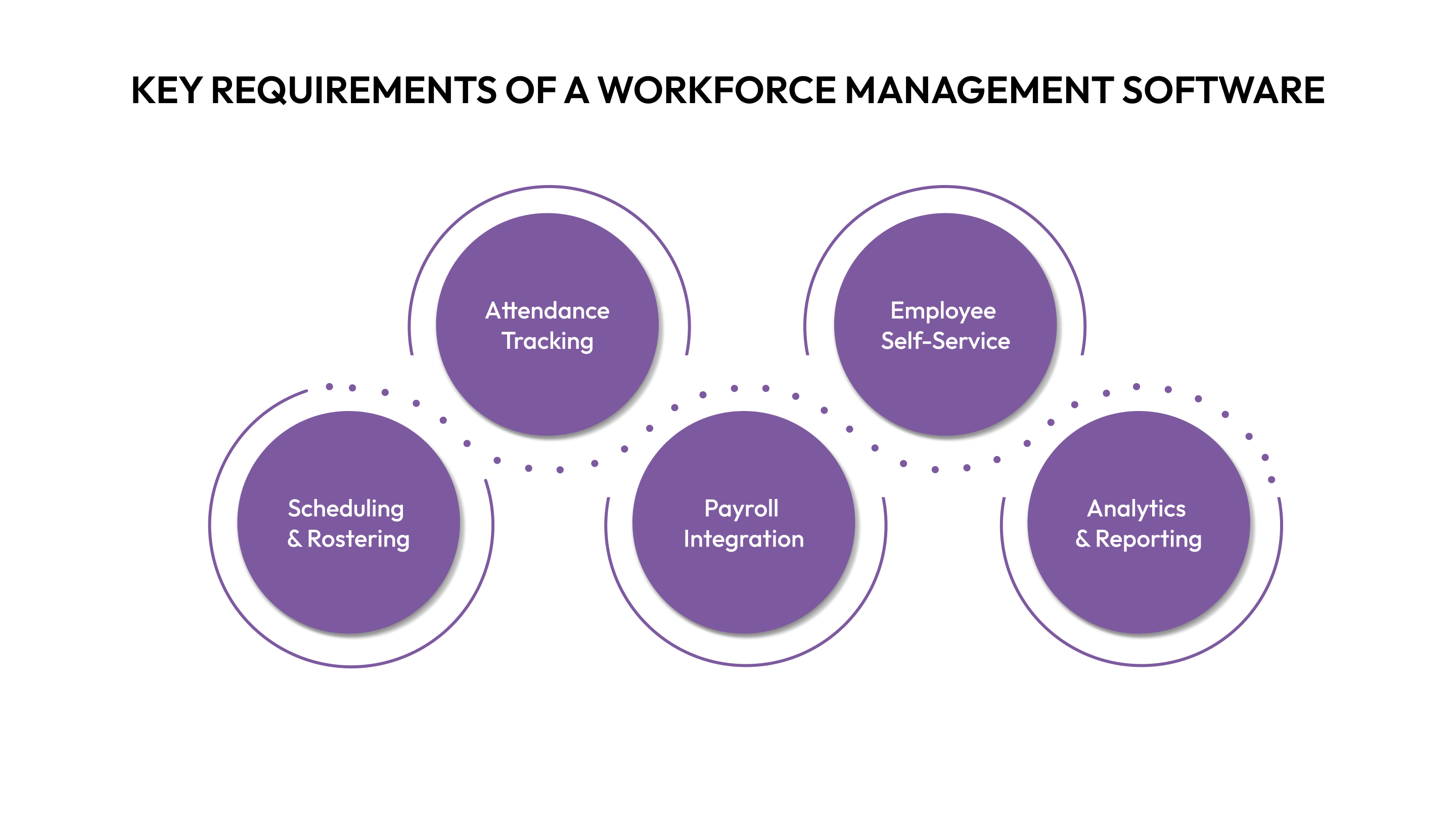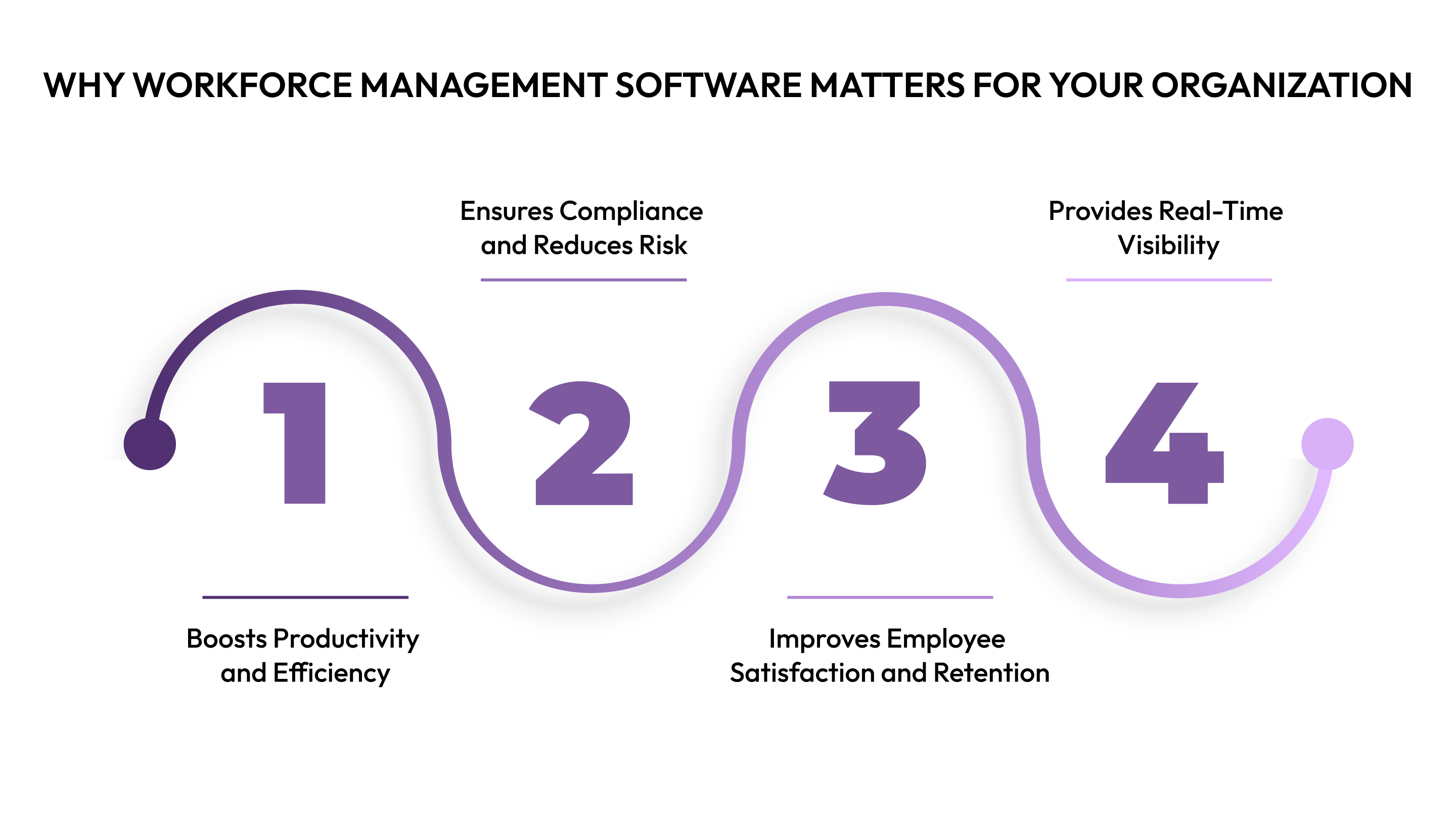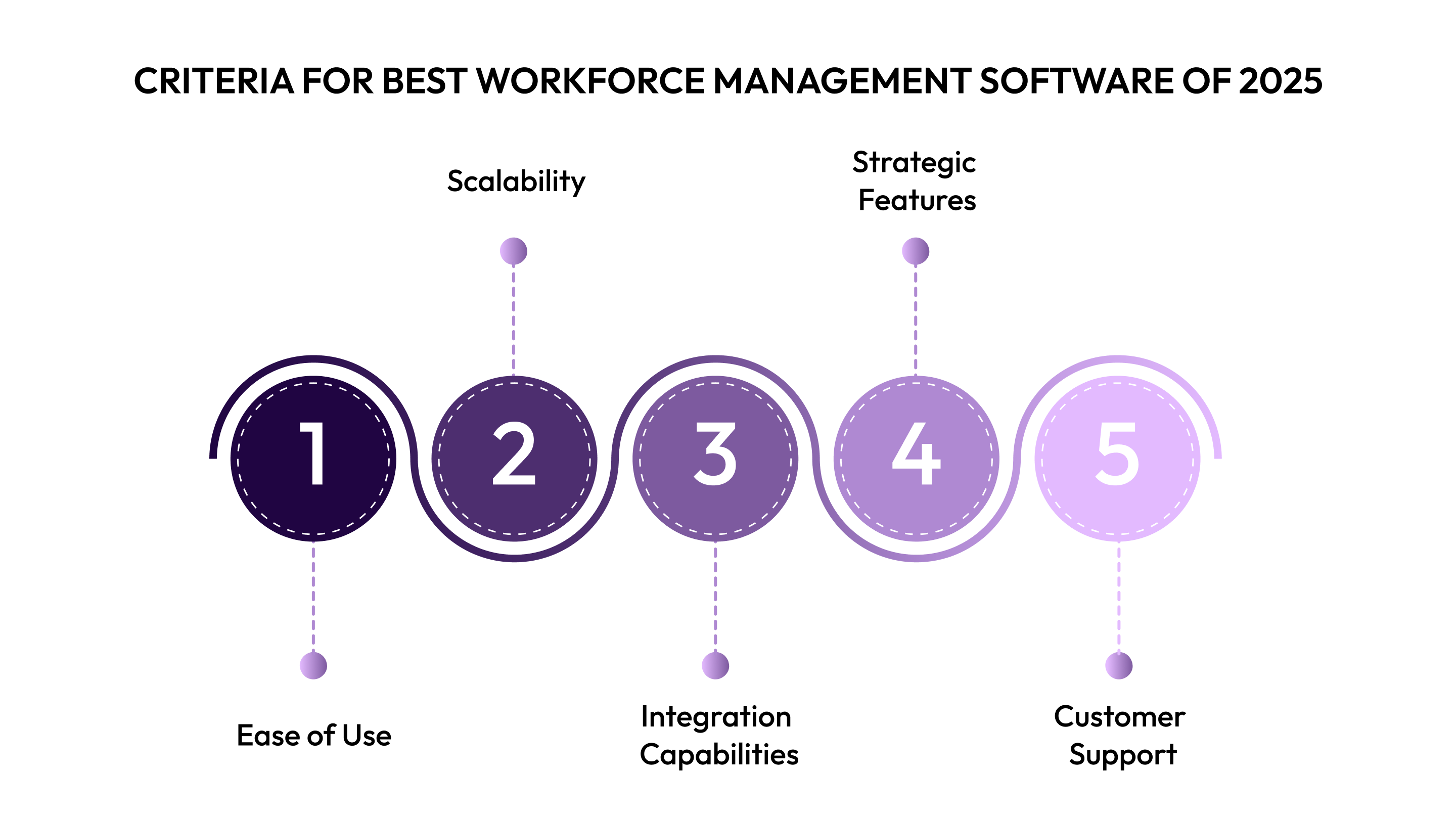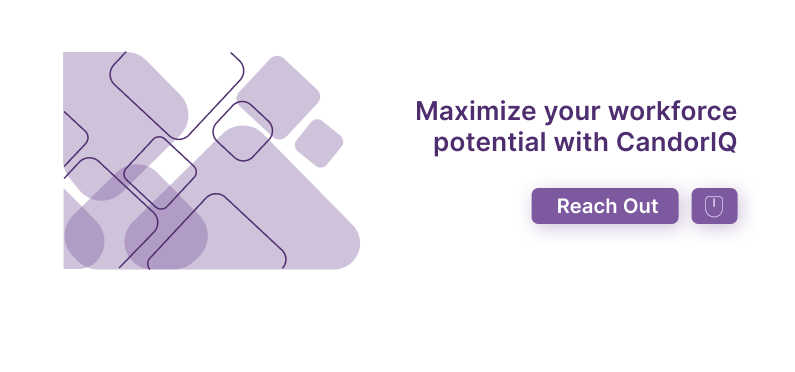Best All-in-One Workforce Management Software 2025
Find the best all-in-one workforce platform for 2025: Streamline payroll, compliance, and HR across global teams. Choose the right tool now!

Managing a growing workforce is one of the biggest challenges any growing company faces today. With teams distributed across geographies and headcount doubling every few years, fragmented tools for payroll, scheduling, and workforce planning only add to the complexity.
Deloitte’s 2025 Human Capital Trends report shows that 75% of companies adopt AI to transform work processes, but few have strategies to help employees manage this change.
This gap drives the need for integrated workforce management platforms that combine technology with people-focused management, enabling fast-growing organizations to adapt effectively.
This blog will explore the best workforce management software of 2025, highlighting how they can simplify key business functions such as scheduling, payroll, compliance, and team collaboration.
At a glance:
- Workforce Management (WFM) software helps founders streamline scheduling, payroll, and headcount planning, going beyond basic HR tasks.
- The best WFM solutions offer real-time analytics, payroll integration, and employee self-service to improve efficiency and reduce risk.
- Founders should prioritize ease of use, scalability, and integration to ensure the software grows with their business.
- CandorIQ is an all-in-one solution that unifies compensation, headcount planning, and retention, helping founders make data-driven decisions and build a transparent organization.
What is Workforce Management Software?
Workforce management (WFM) software is a type of business tool that helps companies manage, optimize, and streamline their day-to-day employee operations. It automates tasks, provides valuable insights, and helps you make better decisions about your most valuable asset: your people.
The goal of this software is to make sure you have the right people in the right places at the right time, all while keeping costs in check and ensuring your team is engaged and productive.
Now that you know what WFM software is, you’re probably thinking, "What features actually matter for a fast-growing company?"
What are the Key Requirements of a Workforce Management Software?

As a founder, you don't have time to implement something that doesn't deliver immediate value. So, before you commit to any platform, here are the core features that truly make a difference for a scaling business:
- Scheduling and Rostering: This is the backbone of any WFM system. It should make it easy to create and manage employee schedules, handle time-off requests, and ensure you have the right coverage without constant back-and-forth. For a distributed team, this is non-negotiable.
- Time and Attendance Tracking: Accurate time tracking is essential for both payroll and compliance. A good system should automatically log hours, breaks, and overtime, giving you a clear audit trail and peace of mind.
- Payroll Integration: Manual data entry between your WFM and payroll systems is a recipe for errors and wasted time. The best solutions integrate seamlessly, so employee hours and compensation flow directly to payroll, ensuring everyone gets paid correctly and on time.
- Employee Self-Service: Your team is busy, and so are you. An employee portal where they can check their schedule, request time off, and view pay stubs empowers them and drastically cuts down on repetitive questions for your lean HR team.
- Analytics and Reporting: You need data to make smart decisions. The right WFM software provides dashboards and reports on key metrics like labor costs, turnover, and performance. This data helps you forecast future needs and spot potential issues before they become problems.
Okay, so you know the requirements. But beyond the features, how does WFM software actually impact your business?
.png)
Also Read: HR Analytics Insights for Strategic Workforce Management
Why Workforce Management Software is Important for Your Organization?

You’re not just building a product; you’re building a company. And a strong company is built on a well-managed team. For a CFO, the benefits of WFM software go beyond simple convenience. They directly impact your bottom line and your ability to scale.
- Boosts Productivity and Efficiency: Every minute your team spends on manual tasks like tracking hours or managing spreadsheets is a minute not spent on innovation or customer growth. WFM software automates these processes, letting your people focus on what they do best.
- Ensures Compliance and Reduces Risk: Navigating complex labor laws is a major headache, especially as you hire across different states or countries. A robust WFM system automatically helps you stay compliant with rules around working hours, overtime, and breaks, protecting your business from costly legal issues.
- Improves Employee Satisfaction and Retention: Transparency is key for today’s workforce. When employees have a clear understanding of their schedules, pay, and total compensation, it builds trust and satisfaction. This clarity can significantly improve retention, a critical factor for a scaling business.
- Provides Real-Time Visibility: You can’t manage what you can’t see. WFM software gives you a single, real-time view of your entire workforce. This visibility is crucial for aligning your people strategy with your financial goals, ensuring your hiring plans don’t outpace your budget.
Now that we’ve covered the "what" and the "why," it's time to talk about the "how." How do you choose the right tool for your business?
Also Read: Workforce Optimization Strategies to Maximize Productivity
Criteria for Best Workforce Management Software of 2025

As a CPO or people ops, you know that the "best" software isn't always the one with the most features; it's the one that fits your specific needs and helps you solve your biggest challenges. To help you evaluate the top options, we focused on what matters most for a growing business.
- Ease of Use: You and your team are busy. The software should be intuitive and easy to use from day one, minimizing training time and maximizing adoption.
- Scalability: Can the platform grow with you? As your team goes from 50 to 500, you need a solution that can handle increased complexity without skipping a beat.
- Integration Capabilities: A truly effective solution plays well with others. It should seamlessly connect with your existing HR, finance, and applicant tracking systems to create a unified workflow.
- Strategic Features: Does the software offer more than just the basics? We looked for platforms that provide advanced features like scenario planning, AI-driven insights, and total compensation management to give you a competitive edge.
- Customer Support: When things go wrong, you need a reliable partner. We evaluated the quality of support and resources available to ensure you’re never left in the dark.
Now let’s see the 10 best workforce management software of 2025 you can choose.
10 Best Workforce Management Software of 2025
Based on the criteria above, ease of use, scalability, integration, strategic features, and support, we've compiled a list of the top workforce management platforms. Each of these solutions has something unique to offer, so you can find the perfect fit for your business.
1. CandorIQ
Best for: Rapidly scaling, mid-sized organizations with distributed teams.
As a CFO, you’re constantly balancing growth with budget. CandorIQ was built for this very challenge. It’s a unified platform that brings together compensation, headcount planning, and retention, so you can manage your workforce strategically.
- Compensation & Payband Builder: Create transparent, location-based pay bands to ensure fair compensation and streamline hiring.
- Headcount Scenario Planning: Model different hiring plans and instantly see their financial impact, so you can make confident, budget-aligned decisions.
- AI Agent: Get data-driven recommendations and answers to your workforce questions, helping you think strategically without digging through spreadsheets.
- Workforce Management: A single dashboard gives you a clear view of your entire organization, from open roles to attrition rates, so you’re always aligned with your plan.
- Total Compensation Transparency: Give your team a clear breakdown of their full compensation, including equity and benefits, to build trust and improve retention.
2. Rippling
Best for: All-in-one HR, IT, and Finance management.
If you’re looking to consolidate everything under one roof, Rippling is a powerful option. It connects your HR, IT, and finance systems, making it easy to manage everything from a single dashboard.
- Global Payroll and HR: Manages global payroll and benefits, ensuring you're compliant in over 150 countries.
- IT and Device Management: Automates IT tasks like device setup and app management, a huge plus for remote teams.
- Employee Onboarding: Simplifies the onboarding process by automating paperwork, device procurement, and access management.
3. Connecteam
Best for: Mobile-first, non-desk employees.
If your team is constantly on the go, Connecteam is designed for them. It’s a mobile-first platform that helps you manage and communicate with your frontline workers.
- Task Management: Assign and track tasks, ensuring every team member knows what to do and when.
- Time Clock & GPS: Employees can clock in and out from their phones, with GPS tracking to verify their location.
- Employee Training: Deliver training materials, quizzes, and surveys directly to employees' phones, making it easy to keep everyone up-to-date.
4. Bamboo HR
Best for: Small to medium-sized businesses looking for a user-friendly HRIS.
Bamboo HR focuses on creating a great employee experience. It’s a clean, intuitive platform that handles all the core HR functions without unnecessary complexity.
- Applicant Tracking System (ATS): Manages the entire hiring process, from posting jobs to extending offers.
- Performance Management: Facilitates performance reviews, goal setting, and 360-degree feedback.
- Custom Reporting: Easily create custom reports on various HR metrics to gain insights into your workforce.
5. Workday HCM
Best for: Large, global enterprises with complex HR needs.
Workday is a leader in the enterprise space. It's built for large, global companies with complex organizational structures and extensive financial needs.
- Talent Management: Provides powerful tools for talent acquisition, performance management, and succession planning.
- Financial Management: Combines HR and financial data in a single system, allowing for unified planning and analysis.
- Global Compliance: Ensures compliance with local labor laws and regulations across multiple countries.
6. ADP Workforce Suite
Best for: Large businesses needing comprehensive payroll and HR services.
ADP is a well-known name in payroll, and its Workforce Suite offers a robust solution for large companies. It's a reliable choice if you need deep payroll and compliance features.
- Robust Payroll: Offers powerful payroll processing, tax filing, and garnishment management.
- Time and Labor Management: Provides advanced time tracking and scheduling with features for leave management and compliance.
- Benefits Administration: Manages benefits enrollment, carrier connections, and compliance reporting.
7. Anaplan
Best for: Financial planning and analysis (FP&A) with a focus on workforce modeling.
Anaplan is a favorite of finance teams. While not a traditional HR tool, it excels at complex financial modeling and is perfect if workforce costs are a major part of your budgeting.
- Scenario Modeling: Models multiple business scenarios and their financial impact, including workforce costs.
- Connected Planning: Aligns finance, HR, and operations to create a single source of truth for planning.
- Predictive Analytics: Uses machine learning to forecast future headcount and compensation needs.
8. Asure
Best for: Small businesses and startups looking for a full-service HR solution.
Asure provides an all-in-one platform for smaller businesses that need help with everything from payroll to HR compliance. It’s a great option for founders who want to offload administrative burdens.
- HR and Payroll: Offers a single platform for managing payroll, taxes, and benefits.
- Employee Engagement: Provides tools for performance management, surveys, and employee feedback.
- Compliance Support: Helps businesses stay compliant with labor laws and regulations.
9. Gusto
Best for: Small businesses with simple payroll and benefits needs.
Gusto is beloved by many small business owners for its user-friendly interface and straightforward approach to payroll. It’s perfect if your primary need is an easy-to-use system for paying your team.
- Automated Payroll: Automates payroll runs, tax filing, and W-2s, making it easy to pay employees.
- Benefits Administration: Offers integrated health insurance, 401(k), and other benefits.
- Contractor Management: Simplifies paying and managing contractors with automated 1099s.
10. Deel
Best for: Global hiring and payroll for remote teams.
If your growth strategy involves hiring talent around the world, Deel is a top choice. It simplifies the complexities of international payroll and compliance, so you can hire anyone, anywhere.
- International Payroll: Manages payroll and compliance for employees and contractors in over 150 countries.
- Contract Management: Creates and manages localized contracts that are compliant with international labor laws.
- Equity and Stock Options: Handles the administration of global equity and stock option plans.
Now that you’ve seen the options, how do you make the right choice for your business?

Tips to Choose the Best Workforce Management Software for Your Business

As a founder, you know that the right tools can make or break your business. Don't rush into a decision that will cost you time and money down the line. Here’s a simple framework to help you choose the best WFM software for your business.
- Start with Your Needs, Not the Features: Before you even look at a single product, clearly define your top 3 pain points. Are you struggling with payroll accuracy? Are your headcount plans always over budget? Your biggest problems should drive your decision.
- Focus on Integration: Your HR, finance, and recruiting systems need to talk to each other. Choose a platform that has a strong track record of integrating with the tools you already use, or the ones you plan to use in the future.
- Get a Live Demo: A website can show you a lot, but a live demo shows you how the product actually works. Ask questions that are specific to your business and get a feel for the team behind the product.
- Think About the Long Term: You’re not just solving for today; you’re building for tomorrow. Select a solution that can scale with you as your team grows from 50 to 500, and from one office to a global, distributed workforce.
Also Read: Key Considerations for Workforce Management Dashboards
Final Thoughts
Your time is your most valuable resource. The right workforce management software can give you more of it by automating routine tasks and giving you the strategic insights you need to make confident decisions.
When you’re able to manage compensation, headcount, and retention from a single source of truth, you’re not just running your business, you’re proactively shaping its future.
CandorIQ was built specifically to solve these challenges for founders like you. It's a platform that unifies your most critical people-related decisions, helping you ensure every hire, raise, and promotion is aligned with your company's vision and budget.
Ready to take control of your workforce planning? Request a demo with the CandorIQ team today and see how you can build a more transparent, equitable, and efficient organization.
FAQs
1. Can workforce management software predict future workforce needs?
Yes, many modern solutions offer predictive analytics that forecast future staffing requirements, skill gaps, and potential turnover, allowing businesses to plan proactively for workforce changes.
2. How do workforce management platforms adapt to gig and remote workforces?
Modern workforce management platforms are built to handle the flexibility required for gig and remote workforces, offering mobile access, flexible scheduling, and tools that ensure compliance across various work arrangements.
3. How do workforce management systems ensure data privacy and compliance with regulations?
Leading platforms prioritize data privacy by implementing robust security measures, including data encryption, secure storage, and compliance with global standards such as GDPR and CCPA, protecting sensitive employee information.
4. Do workforce management platforms integrate with existing HR and payroll systems?
Yes, many top workforce management solutions offer seamless integration with HRIS, payroll, and other business systems, providing a unified approach to employee management and data synchronization.


